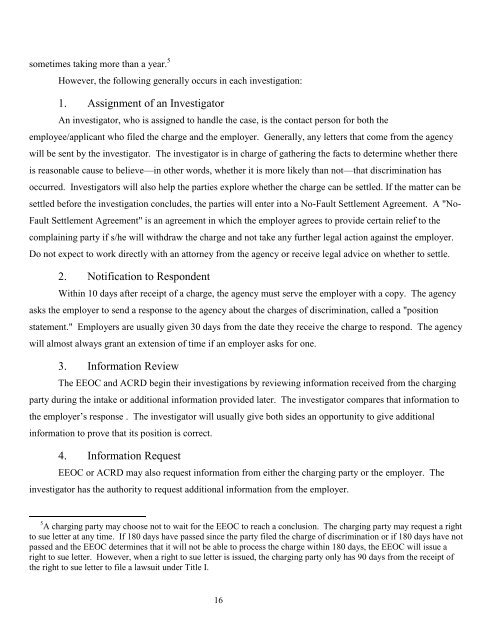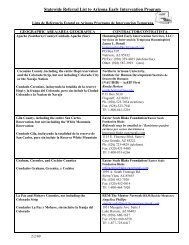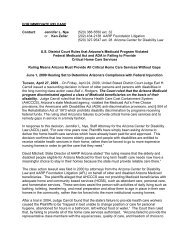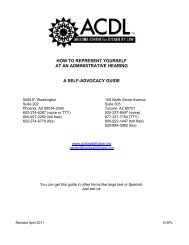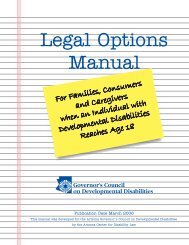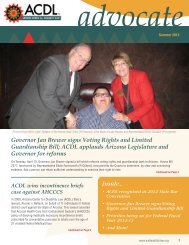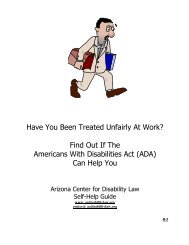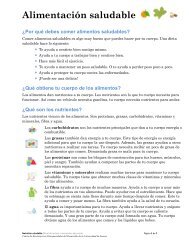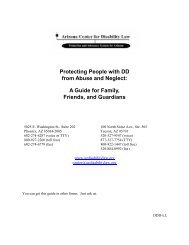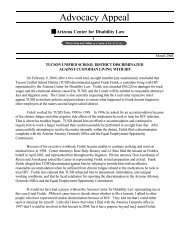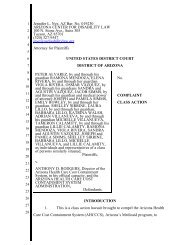How to Enforce Employment Rights Under the Americans with ...
How to Enforce Employment Rights Under the Americans with ...
How to Enforce Employment Rights Under the Americans with ...
You also want an ePaper? Increase the reach of your titles
YUMPU automatically turns print PDFs into web optimized ePapers that Google loves.
sometimes taking more than a year. 5<strong>How</strong>ever, <strong>the</strong> following generally occurs in each investigation:1. Assignment of an Investiga<strong>to</strong>rAn investiga<strong>to</strong>r, who is assigned <strong>to</strong> handle <strong>the</strong> case, is <strong>the</strong> contact person for both <strong>the</strong>employee/applicant who filed <strong>the</strong> charge and <strong>the</strong> employer. Generally, any letters that come from <strong>the</strong> agencywill be sent by <strong>the</strong> investiga<strong>to</strong>r. The investiga<strong>to</strong>r is in charge of ga<strong>the</strong>ring <strong>the</strong> facts <strong>to</strong> determine whe<strong>the</strong>r <strong>the</strong>reis reasonable cause <strong>to</strong> believe—in o<strong>the</strong>r words, whe<strong>the</strong>r it is more likely than not—that discrimination hasoccurred. Investiga<strong>to</strong>rs will also help <strong>the</strong> parties explore whe<strong>the</strong>r <strong>the</strong> charge can be settled. If <strong>the</strong> matter can besettled before <strong>the</strong> investigation concludes, <strong>the</strong> parties will enter in<strong>to</strong> a No-Fault Settlement Agreement. A "No-Fault Settlement Agreement" is an agreement in which <strong>the</strong> employer agrees <strong>to</strong> provide certain relief <strong>to</strong> <strong>the</strong>complaining party if s/he will <strong>with</strong>draw <strong>the</strong> charge and not take any fur<strong>the</strong>r legal action against <strong>the</strong> employer.Do not expect <strong>to</strong> work directly <strong>with</strong> an at<strong>to</strong>rney from <strong>the</strong> agency or receive legal advice on whe<strong>the</strong>r <strong>to</strong> settle.2. Notification <strong>to</strong> RespondentWithin 10 days after receipt of a charge, <strong>the</strong> agency must serve <strong>the</strong> employer <strong>with</strong> a copy. The agencyasks <strong>the</strong> employer <strong>to</strong> send a response <strong>to</strong> <strong>the</strong> agency about <strong>the</strong> charges of discrimination, called a "positionstatement." Employers are usually given 30 days from <strong>the</strong> date <strong>the</strong>y receive <strong>the</strong> charge <strong>to</strong> respond. The agencywill almost always grant an extension of time if an employer asks for one.3. Information ReviewThe EEOC and ACRD begin <strong>the</strong>ir investigations by reviewing information received from <strong>the</strong> chargingparty during <strong>the</strong> intake or additional information provided later. The investiga<strong>to</strong>r compares that information <strong>to</strong><strong>the</strong> employer’s response . The investiga<strong>to</strong>r will usually give both sides an opportunity <strong>to</strong> give additionalinformation <strong>to</strong> prove that its position is correct.4. Information RequestEEOC or ACRD may also request information from ei<strong>the</strong>r <strong>the</strong> charging party or <strong>the</strong> employer. Theinvestiga<strong>to</strong>r has <strong>the</strong> authority <strong>to</strong> request additional information from <strong>the</strong> employer.5 A charging party may choose not <strong>to</strong> wait for <strong>the</strong> EEOC <strong>to</strong> reach a conclusion. The charging party may request a right<strong>to</strong> sue letter at any time. If 180 days have passed since <strong>the</strong> party filed <strong>the</strong> charge of discrimination or if 180 days have notpassed and <strong>the</strong> EEOC determines that it will not be able <strong>to</strong> process <strong>the</strong> charge <strong>with</strong>in 180 days, <strong>the</strong> EEOC will issue aright <strong>to</strong> sue letter. <strong>How</strong>ever, when a right <strong>to</strong> sue letter is issued, <strong>the</strong> charging party only has 90 days from <strong>the</strong> receipt of<strong>the</strong> right <strong>to</strong> sue letter <strong>to</strong> file a lawsuit under Title I.16


